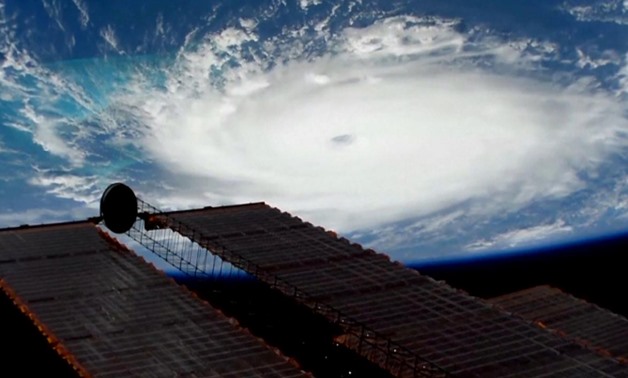
Hurricane Dorian is viewed from the International Space Station September 1, 2019 in a still image obtained from a video. NASA/Handout via REUTERS
Titusville, Fla.- 2 September 2019: Hurricane Dorian battered the Bahamas early on Monday, peeling off roofs, toppling cars and snapping power lines as rising floodwater threatened to engulf houses.
The second-strongest Atlantic storm on record was forecast to pound the archipelago through the day, then move slowly toward the east U.S. coast, where authorities ordered more than a million people evacuated in Florida, South Carolina and Georgia.
There were no immediate estimates of casualties as the category five storm covered the northwestern islands of Great Abaco and Grand Bahama with twisted metal and splintered wood.
Winds gusting up to 200 mph (320 kph) destroyed or damaged more than 13,000 homes, the International Federation of Red Cross and Red Crescent Societies said.
Residents posted images online of water rising up the side of their houses. The National Hurricane Center (NHC) in Miami warned of a possible storm surge that could push destructive waves higher than many roofs in the islands.
As of 5 a.m. (0900 GMT), Dorian was stalled over the Grand Bahama Island barely drifting westward at 1 mph, according to the NHC.
It was about 125 miles (200 km) from the Florida coast, where residents said they were already experiencing strong winds and high surf.
Palm Beach County, the third most-populated county and home to President Donald Trump’s Mar-a-Lago resort, was among those with partial mandatory evacuations. Other counties announced voluntary evacuations.
“This looks like it could be larger than all of them,” Trump said during a briefing with the Federal Emergency Management Agency (FEMA) on Sunday.
EVACUATIONS
Julia Eaddy, 70, in Titusville, Florida, said she and her husband had ridden out several hurricanes before and were not fazed by the forecast. “I think it will be more of the same,” she said.
Several gasoline stations around Titusville were closed. Many grocery stores were open but boarded up. Inside, shelves emptied out fast.
Farther north, South Carolina Governor Henry McMaster ordered mandatory evacuations for parts of eight coastal counties effective at noon on Monday. More than 830,000 people were under evacuation orders in Charleston and other coastal communities in South Carolina, emergency management officials announced.
Georgia Governor Brian Kemp ordered evacuations in six coastal counties, including all of Savannah 150,000 residents, also effective at noon on Monday, Kemp’s office said on Twitter.
Evacuations ordered in Florida included 14,000 people in St. Augustine. Authorities said they would release more details during the day as the hurricane’s path became clearer.
“The hurricane will move dangerously close to the Florida east coast late Monday through Tuesday night,” the NHC said. Even a glancing blow from one of the strongest storms could bring torrential rains and damaging winds, it added.
Dorian is the strongest hurricane on record to hit the northwestern Bahamas as a life-threatening Category 5 storm on the five-step Saffir-Simpson Wind Scale.
It was tied with Gilbert (1988), Wilma (2005) and the 1935 Labor Day hurricane for the second-strongest Atlantic hurricane on record, based on maximum sustained winds. Allen in 1980 was the most powerful, with 190 mph (306 kph) winds, the NHC said.
Dorian is expected to remain a hurricane for the next five days and move northwest along or near the U.S. east coast, forecasters said.


Comments
Leave a Comment